Acute Post Operative Pain Management Emma Lamont - 18 Weeks
Acute Post Operative Pain Management Emma Lamont - 18 Weeks
Acute Post Operative Pain Management Emma Lamont - 18 Weeks
You also want an ePaper? Increase the reach of your titles
YUMPU automatically turns print PDFs into web optimized ePapers that Google loves.
NHS National Waiting Times Centre<br />
<strong>Acute</strong> <strong>Post</strong> <strong>Operative</strong> <strong>Pain</strong> <strong>Management</strong><br />
<strong>Emma</strong> <strong>Lamont</strong>
NHS National Waiting Times Centre<br />
The Patient in <strong>Pain</strong><br />
• “By any reasonable code, freedom from pain should be a basic<br />
human right limited only by our knowledge of achieving it”<br />
• Liebeskind & Melzack<br />
<strong>Pain</strong>. 1987.<br />
• “<strong>Pain</strong> is whatever the person experiencing it says it is, existing<br />
whenever the person says it does”<br />
• McCaffery 1968<br />
• “an unpleasant sensory and emotional experience associated<br />
with actual or potential tissue damage or it is described in terms<br />
of such damage”<br />
• The International association<br />
for the study of pain
NHS National Waiting Times Centre<br />
<strong>Pain</strong><br />
“<strong>Pain</strong> is a multifactorial experience, not just a<br />
sensation. Emotion,perception and past experience<br />
all affect an individuals response to noxious stimuli.<br />
Improved post operative pain control through<br />
innovation and creativity may improve compliance,<br />
ease of delivery, reduce symptoms and aggressive<br />
treatment of pain using an integrative approach,<br />
combining pharmacotherapy as well as<br />
complementary technique, should serve us well in<br />
dealing with this complex problem”<br />
• Shang & Gan, Optimising <strong>Post</strong> operative pain<br />
management in the ambulatory patient. 2003
NHS National Waiting Times Centre<br />
Why manage <strong>Pain</strong>?<br />
• Humanitarian<br />
• “By any reasonable code, freedom from pain should be a basic<br />
human right limited only by our knowledge of achieving it”<br />
- Liebeskind & Melzack <strong>Pain</strong>. 1987.<br />
• Cost Effectiveness<br />
* <strong>Pain</strong> impedes mobilisation after surgery<br />
and may lead to such things as:<br />
–<strong>Post</strong> operative complications (leading to<br />
delayed stay in hospital or ICU admission)<br />
–Deep Vein Thrombosis<br />
–Pressure sores<br />
• Respiratory Function<br />
• Cardiovascular system<br />
• Gastrointestinal system<br />
• Stress response to surgery<br />
* Good pain relief ensures:<br />
–Less post operative<br />
complications<br />
–Earlier discharge from Hospital<br />
–Less demands on Clinical time
NHS National Waiting Times Centre<br />
The Patient in <strong>Pain</strong><br />
• <strong>Pain</strong>, the 5 th Vital Sign<br />
• Kathy Quan 2006<br />
• <strong>Pain</strong> is always subjective.<br />
• No direct test or observation can accurately<br />
determine whether a patient is in pain.<br />
• How do we assess pain?<br />
• Look<br />
• Listen<br />
• Assess, review, document and re-assess
NHS National Waiting Times Centre<br />
The Patient in <strong>Pain</strong><br />
• How do we assess & document pain?<br />
• Behaviour<br />
• Expressions, body language, physiology<br />
• Verbal Scale<br />
• None, Mild, Moderate, Severe<br />
• Numerical<br />
• 1, 2, 3, 4<br />
• Visual Analogue<br />
• Wong Baker, 10cm ruled line
NHS National Waiting Times Centre<br />
Why We Assess <strong>Pain</strong><br />
• To improve patient care<br />
• As a means of standardising each individual<br />
patients pain.<br />
• For legal reasons<br />
• To support actions<br />
• To improve surgical outcome<br />
• Audit/research purposes<br />
• QIS & NICE guidelines say we have to!
NHS National Waiting Times Centre<br />
Why have a “<strong>Pain</strong> Service”?<br />
Joint College Report on<br />
“<strong>Pain</strong> After Surgery”, 1990.<br />
• “<strong>Pain</strong> – a subjective experience that can be<br />
perceived directly only by the sufferer.”<br />
• “The treatment of pain after surgery in British<br />
Hospitals has been inadequate and has not<br />
advanced significantly for many years.”
NHS National Waiting Times Centre<br />
The Patient in <strong>Pain</strong><br />
“Multimodal Analgesia”<br />
• A combination of analgesia resulting with a<br />
synergistic affect<br />
• Well described in the available Medical Literature<br />
• The goal of pain management is not necessarily<br />
“zero” pain rather it is the maximally functional<br />
patient, with the patient ultimately deciding if the<br />
goal has or has not been reached.<br />
• Kathy Quan 2007
NHS National Waiting Times Centre<br />
The Patient in <strong>Pain</strong><br />
• Key points<br />
• Multimodal Analgesia<br />
• No one dose or analgesia suits all patients<br />
• We are individuals and should be treated as such<br />
• Assessment of the patient experiencing pain is the<br />
cornerstone to optimal pain management.<br />
• <strong>Pain</strong> assessment should be ongoing, individualised,<br />
and documented.<br />
• <strong>Pain</strong> relief should be a basic human right


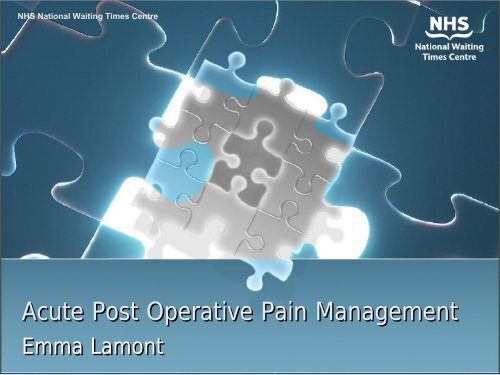
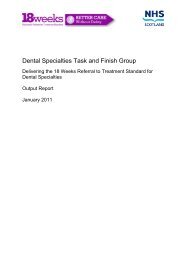
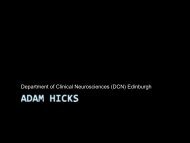
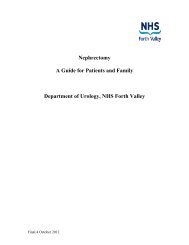
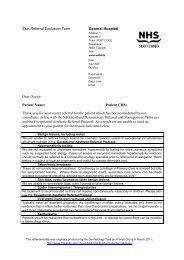
![Dr Matthew Checketts, NHS Tayside [PDF - 6Mb] - 18 Weeks](https://img.yumpu.com/49027155/1/190x143/dr-matthew-checketts-nhs-tayside-pdf-6mb-18-weeks.jpg?quality=85)
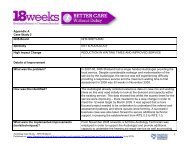
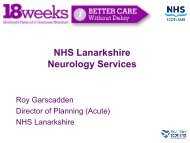
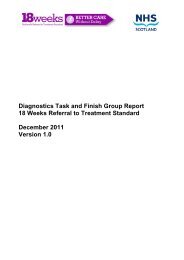

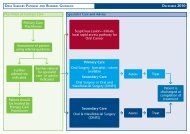


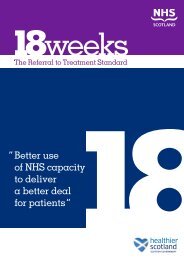
![Mark Sindall, NHS Dumfries and Galloway [PDF - 227Kb] - 18 Weeks](https://img.yumpu.com/30080335/1/190x143/mark-sindall-nhs-dumfries-and-galloway-pdf-227kb-18-weeks.jpg?quality=85)